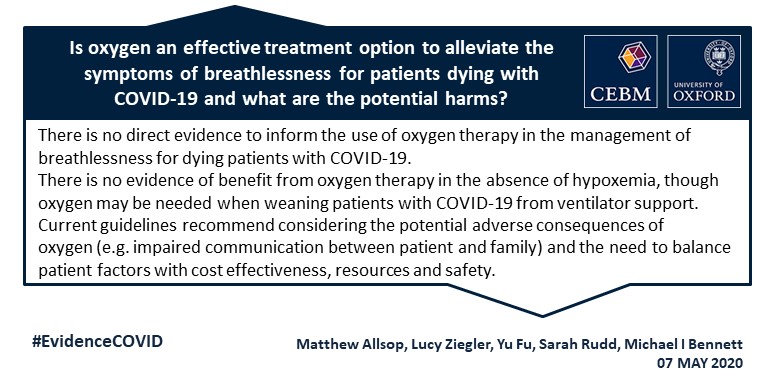why give oxygen at end of life
Morphine can reduce the anxiety associated with shortness of breath but actually improves breathing by dilating blood vessels in the lungs. By having a sufficient quantity of oxygen in the blood the body is able to function properly and cells are healthy.
As well oxygen cannot ever be used to eat up or to catch up when the cell or tissue is not there.

. What we have learned that seems to be more helpful than administering oxygen is to give a small amount the operative word here is small of Morphine. Oxygen is sometimes prescribed for non-hypoxemic patients to relieve dyspnea. In the awake hypoxic patient near the end of life encourage nasal prongs rather than a mask so there is less of a barrier between the patient and the family.
Reversal of hypoxemia in some cases will alleviate dyspnea. Oxygen a gas found in the air we breathe is necessary for human life. Oxygen at the end of life can be considered a comfort measure for the family.
Clinical guidelines recommend oxygen when blood oxygen levels fall so low that a patient becomes hypoxic -- when there isnt enough oxygen in the blood to keep vital functions going. The Morphine can actually bring comfort from air hunger at end of life. That research demonstrates that some palliative practices may not only be ineffective but cause patients additional discomfort.
Oxygen is commonly prescribed for lung cancer patients with advancing disease. The Morphine can actually bring comfort from air hunger at end of life. While some patients may derive symptomatic benefit recent studies demonstrate that.
Providing support for practical tasks. Why do you give a patient oxygen. Unless special guidelines apply to the end of life oxygen use is as follows.
Oxygen a gas found in the air we breathe is necessary for human life. Indications include hypoxemia and dyspnea. In the awake hypoxic patient near the end of life encourage nasal prongs rather than a mask so there is less of a barrier between the patient and the family.
The purpose of this study was to investigate the use of oxygen at the end of life and to understand its role in contemporary palliative care practice. Luckily there are a few simple and effective treatments that can bring quick relief such as deep-breathing exercises relaxation techniques oxygen and medications. Some people with breathing disorders cant get enough oxygen naturally.
Pantilat presented data related to five commonly-used strategies in end-of-life care. They may need supplemental oxygen or oxygen therapy. Morphine aIf patient is short of breath.
Death can come suddenly or a person may linger in a near-death state for days weeks or even months. 2-4 liters per minute. Millions of patients with advanced disease in palliative care settings receive oxygen therapy to help them breathe more easily.
Value of oxygen therapy in end-of-life care challenged in new study. Morphine is also effective in treating dyspnea or shortness of breath a symptom experienced by a very large number of people at the end of life and sometimes more distressing than physical pain. Others remain physically strong while cognitive function declines.
Oxygen therapy is a treatment for patients who have a health condition which causes low levels of oxygen in the blood hypoxaemia. In the days to hours before death we need to. Walk through any hospital and youll see plenty of patients receiving supplemental oxygen for shortness of breath.
Morphine 20 mgmL oral concentrate. Oxygen aIf patient is short of breath. BIf patient cIf patient Hospice General Order Set.
Why Do We Give Oxygen To Patients. Some patients find oxygen masks feel more suffocating and claustrophobic than nasal prongs even though the mask might be providing the needed amount of oxygen. It slows down the number of times a person breaths in and out.
Care at end of life continues. Each experience is different at the end of life. Shortness of breath or breathing difficulties are among the most common symptoms at the end of life.
For some older adults at the end of life the body weakens while the mind stays clear. Some amount of breathlessness is common in most people as they near death. This helps to reduce symptoms such as breathlessness and can make day-to-day activities easier to manage.
People who receive oxygen therapy often see improved energy levels and sleep and better quality of life. Shortness of Breath. The project involved a survey to learn about medical facility practices regarding the use of oxygen at the end of life and attitudes and.
Breathing in air with added oxygen increases the level of oxygen in the blood.
.jpg?width=960&name=Cerebral%20Hypoxia,%20Cerebral%20Anoxia,%20Oxygen%20Deprivation%20(1).jpg)
How Long Can The Brain Go Without Oxygen What Happens

C H R I S T I A N On Instagram The Zz Plant Is One Of Those That Every Plant Enthusiast And Beginners Needs To Have In Their Collection So Easy To Care For Yet So

Trees Are Way More Powerful Thank You Think Infographic

Oxygen Saturation Respiratory Rate Predict Covid 19 Mortality

This Is Real Life You Know The Trees Are Growing And They Give Oxygen To The Planet They Don T Take It Away Like You Know Traffic Jams Sometimes I Just F

O2 Sign In Blue Water Stock Illustration Illustration Of Sign 24218065

Is Oxygen An Effective Treatment Option To Alleviate The Symptoms Of Breathlessness For Patients Dying With Covid 19 And What Are The Potential Harms The Centre For Evidence Based Medicine

How To Make A Warm Home With Green Plants And Flowers Lily Fashion Style Home House Design Home Decor

What You Need To Know About Brain Oxygen Deprivation

Compounds Ending In Ate Teacher Guides 12th Grade Interactive

Seriously Ill Too Much Oxygen Dangerous

Portable Oxygen Concentrator 2 0 With Adjustable Flow Full Oxygen Therapy At Home Oxygen Concentrator Oxygen Therapy Oxygen

Boca Collection Set Of 2 By Accent Decor In 2021 Accent Decor Rattan Bamboo Diy






